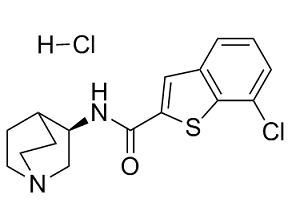Encenicline HCl salt (EVP6124; MT4666)
This product is for research use only, not for human use. We do not sell to patients.

For small sizes, please check our retail website as below: www.invivochem.com
| Size | Price | Stock |
|---|---|---|
| 50mg | $990 | Check With Us |
| 100mg | $1650 | Check With Us |
| 200mg | $2475 | Check With Us |
Cat #: V15400 CAS #: 550999-74-1 Purity ≥ 99%
Description: Encenicline (EVP-6124; MT-4666) is a novel partial agonist of α7 nicotinic acetylcholine receptor.
Top Publications Citing Invivochem Products
Publications Citing InvivoChem Products
Product Promise

- Physicochemical and Storage Information
- Protocol
- Related Biological Data
- Stock Solution Preparation
- Quality Control Documentation
| Molecular Weight (MW) | 357.30 |
|---|---|
| Molecular Formula | C16H18Cl2N2OS |
| CAS No. | 550999-74-1 |
| Protocol | In Vitro | Encenicline (EVP-6124) displaces [3H]-MLA (Methyllycaconitine) (Ki=9.98 nM, pIC50=7.65±0.06, n=3) and [125I]-α-bungarotoxin (Ki=4.33 nM, pIC50=8.07±0.04, n=3). Encenicline (EVP-6124) is approximately 300 fold more potent than the natural agonist ACh (Ki=3 μM), measured in binding assays using [3H]-MLA. Encenicline hydrochloride inhibits the 5-HT3 receptor by 51% at 10 nM, the lowest concentration tested. Evaluation of the human 5-HT2B receptor expressed in CHO cells demonstrates displacement of [3H]-mesulergine (Ki=14 nM) and only antagonist activity in the rat gastric fundus assay at an IC50 of 16 μM. In binding and functional experiments, Encenicline (EVP-6124) shows selectivity for α7 nAChRs and does not activate or inhibit heteromeric α4β2 nAChRs |
|---|---|---|
| In Vivo | Encenicline hydrochloride has good brain penetration and an adequate exposure time. Encenicline hydrochloride (0.3 mg/kg, p.o.) significantly restores memory function in scopolamine-treated rats (0.1 mg/kg, i.p.) in an object recognition task (ORT). Although donepezil at 0.1 mg/kg, p.o. or Encenicline hydrochloride at 0.03 mg/kg, p.o. did not improve memory in this task, co-administration of these sub-efficacious doses fully restored memory. In a natural forgetting test, an ORT with a 24 h retention time, Encenicline hydrochloride improved memory at 0.3 mg/kg, p.o. This improvement is blocked by the selective α7 nAChR antagonist methyllycaconitine (0.3 mg/kg, i.p. or 10 μg, i.c.v.). Encenicline hydrochloride is found to bind moderately to rat plasma proteins with a mean fu of 0.11±0.01 (mean±SD) or 11%. Over a range of 0.1-30 mg/kg, p.o., Encenicline hydrochloride demonstrates proportional dose escalation. Tmax is at 4 h in plasma and 2 h brain, although the brain concentrations remained similar between 2 and 8 h. The B:P ratios are 1.7-5.1 between 1 and 8 h |
These protocols are for reference only. InvivoChem does not
independently validate these methods.
| Solvent volume to be added | Mass (the weight of a compound) | |||
|---|---|---|---|---|
| Mother liquor concentration | 1mg | 5mg | 10mg | 20mg |
| 1mM | 2.7988 mL | 13.9938 mL | 27.9877 mL | 55.9754 mL |
| 5mM | 0.5598 mL | 2.7988 mL | 5.5975 mL | 11.1951 mL |
| 10mM | 0.2799 mL | 1.3994 mL | 2.7988 mL | 5.5975 mL |
| 20mM | 0.1399 mL | 0.6997 mL | 1.3994 mL | 2.7988 mL |
The molarity calculator equation
Mass(g) = Concentration(mol/L) × Volume(L) × Molecular Weight(g/mol)
Mass
=
Concentration
×
Volume
×
Molecular Weight*
The dilution calculator equation
Concentration(start)
×
Volume(start)
=
Concentration(final)
×
Volume(final)
This equation is commonly abbreviated as: C1 V1 = C2 V2
Concentration(start)
C1
×
Volume(start)
V1
=
Concentration(final)
C2
×
Volume(final)
V2
Step One: Enter information below
Dosage mg/kg
Average weight of animals g
Dosing volume per animal µL
Number of animals
Step Two: Enter the in vivo formulation
%DMSO
+
%
+
%Tween 80
+
%ddH2O
Calculation Results:
Working concentration:
mg/ml;
Method for preparing DMSO master liquid:
mg
drug pre-dissolved in
µL
DMSO(Master liquid concentration
mg/mL)
,Please contact us first if the concentration exceeds the DMSO solubility of the batch of drug.
Method for preparing in vivo formulation:
Take
µL
DMSO master liquid, next add
µL
PEG300, mix and clarify, next add
µL
Tween 80,mix and clarify, next add
µL
ddH2O,mix and clarify.
Note:
- (1) Please be sure that the solution is clear before the addition of next solvent. Dissolution methods like vortex, ultrasound or warming and heat may be used to aid dissolving.
- (2) Be sure to add the solvent(s) in order.




































